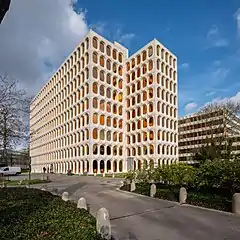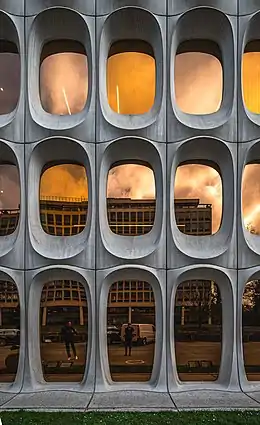CBR Building
The CBR Building is an office building situated in Watermaal-Bosvoorde in Brussels, designed by architects Constantin Brodzki and Marcel Lambrichs.[1]
| CBR Building | |
|---|---|
 Backside of the CBR Building | |
| General information | |
| Architectural style | New Brutalism |
| Location | Watermaal-Bosvoorde Brussels |
| Construction started | 1967 |
| Completed | 1970 |
| Renovated | 2018 |
| Design and construction | |
| Architect | Constantin Brodzki Marcel Lambrichs |


Its prefabricated modular facade showcases white concrete instead of hiding it as a construction material, classifying the building as a New Brutalist piece of architecture.[2][3]
In November 2018 it was added to the list of protected heritage within the Brussels Capital Region.[1]
Prefabricated concrete modules
Brodzki saw the potential of using concrete as more than just a construction material and wanted to exploit its formal freedom to create organic shapes. It took him years, in cooperation with the CBR company and two Portuguese brothers, to be able to craft the prefabricated modules used in the facade. They started by producing dozens of different testing models which, once perfected, were used to create a mould in epoxy. This mould was used to produce the 756 modules needed for the facade of the building, after which the construction happened very quickly. This method of construction allowed the building to be erected as fast as one floor per week.[4]
Original interior
Every material, detail and finishing in the building was chosen by the architects themselves, even the buttons on the elevator. Some of the furniture Brodzki designed himself in collaboration with his friend and neighbour, Jules Wabbes, a Belgian interior architect.[4]
Location
The CBR building is adjacent to the Sonian Forest and 10 minutes away from Avenue Louise connecting the city center of Brussels.[5]
The gardens surrounding the building are created by René Pechère, a Belgian landscape architect. Some of his works include the gardens of the Expo 58, the Parisian world expo in 1937, the upper part of the Botanical Garden of Brussels, Kunstberg and more. His work is still visible around the building, surrounding it in a vibrant green landscape.[6]
Its neighbouring buildings are exclusively dedicated to office based architecture, strictly distinguished from the residential neighbourhoods closer to the city center. The office scenery is divided by two large crossing roads, bringing in a constant flow of traffic.
Occupation
The construction was initiated in 1967 by the CBR cement company, as they needed new infrastructure for their headquarters. They produce and sell a large variety of cements for construction in Brussels. [7]The aim for the building was to showcase their abilities and knowledge in working with concrete.
In 2017 the CBR was forced to move their headquarters, as the building was no longer up to their standards. The building went vacant for a year after which the co-working company Fosbury & Sons, founded by Stijn Geeraerts, Maarten Van Gool and Serge Hannecart, saw their opportunity and occupied the building to create new coworking spaces. Now the building is often used for public lectures and events as it accommodates a small auditorium, a restaurant, a bar and even a small club. [2][5]
Renovation
When in 2017 the CBR moved their headquarters, there was concern that the building would be demolished. Twenty-five architects petitioned for the preservation of the building. Rudi Vervoort, prime minister of the Brussels Capital Region responded by initiating the process of adding the CBR Building to the list of protected heritage in Brussels (which protects the building's exterior). Later on he also assured an optimal preservation of the building during its renovation by Fosbury & Sons.[8][6]
In 2019 the renovation was complete and Fosbury & Sons occupied the building. The original wooden cabinets were disassembled, renovated and reinstalled - the concrete staircase with its handrail was renovated as well. Most of the other original pieces such as the built-in units, authentic door handles, radiator caps and wooden window casings were preserved. There were also modern additions, which kept in mind the original materials, as to not disrupt the architectural unity. [2]
Publications
The CBR building was the only Belgian project selected for the 1979 MoMA exhibition - ‘Transformations in Modern Architecture between 1960 and 1980’ , where it was celebrated for setting a precedent in expressive facades using prefabricated concrete modules.[3][2]
The building was also mentioned in a publication by the KU Leuven Faculty of Architecture called WTC Tower Teachings, where Marc Dubois described the CBR Building as an example of qualitative real estate architecture within Brussels.[9]
References
- "Watermaal-Bosvoorde - CBR gebouw - Terhulpsesteenweg 185 - LAMBRICHS Marcel". www.irismonument.be. Retrieved 2020-05-09.
- "New brutalism: Constantin Brodzki's Brussels HQ is up for renovation by Fosbury & Sons". Wallpaper*. 2018-06-28. Retrieved 2020-05-09.
- Belgium, Docomomo. "Immeuble CBR". Retrieved 2020-05-09.
- "Iconisch Brussels kantoorgebouw krijgt make-over". De Tijd (in Dutch). 2018-11-16. Retrieved 2020-04-26.
- "Fosbury & Sons strijkt neer in Brussel". De Standaard (in Dutch). Retrieved 2020-05-09.
- Belgium, Docomomo. "(FR-NL) Bâtiment CBR protégé/ CBR-bebouw beschermd". Retrieved 2020-05-09.
- "Wie zijn wij?". www.cbr.be (in Dutch). Retrieved 2020-05-09.
- "Duizenden ondertekenen petitie om CBR-gebouw te redden". www.bruzz.be (in Dutch). Retrieved 2020-05-09.
- WTC Tower Teachings. Campus Sint-Lucas: KU Leuven Faculty of Architecture. 2019. pp. 166–167.
- Interior of the CBR building after its renovation by Fosbury & Sons
 Communal space in the top floor of the building
Communal space in the top floor of the building A refurbished meeting room in the CBR building
A refurbished meeting room in the CBR building Co-working spaces on the ground floor, right next to the reception
Co-working spaces on the ground floor, right next to the reception